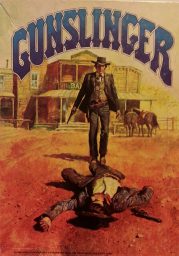 In the early days of the role playing hobby, particularly in the rapid expansion days when the craze was really starting to hit in the late ‘70s and early ‘80s, there was a lot of jumping on the bandwagon. Games were rushed out not fully tested or other types of games had role playing elements tacked on as an afterthought. Then there were some games whose role playing elements were up front but, so lightly handled that many people missed that that they were role playing games at all. And, some of these were great but, a lot of these things were of mixed quality as one might expect.
In the early days of the role playing hobby, particularly in the rapid expansion days when the craze was really starting to hit in the late ‘70s and early ‘80s, there was a lot of jumping on the bandwagon. Games were rushed out not fully tested or other types of games had role playing elements tacked on as an afterthought. Then there were some games whose role playing elements were up front but, so lightly handled that many people missed that that they were role playing games at all. And, some of these were great but, a lot of these things were of mixed quality as one might expect.
But, perhaps the narrative above isn’t quite fair. As mentioned in my previous review of Privateers and Gentlemen, role playing games grew out of the war gaming hobby. Prior to the development of role playing games there was the idea of the “campaign game”; meaning a series of linked scenarios that tell a greater story than playing out just one battle. To this day, a group of linked role playing sessions is most often referred to as “a campaign”. There was a lot of parallel development and the lines between a campaign game and a role playing game were not as clear-cut as they seem today. So, once D&D hit it big there was indeed a bunch of band-wagon jumping but, there was also just the natural evolution of publishing the various role playing aspects that people in the hobby had been experimenting with. The result of this was a lot of games were not-quite-role-playing games. And, it’s no surprise that the great grand-daddy of war gaming Avalon Hill published a lot of them. Of these, the game I think came the closest while not quite hitting the mark was the game Gunslinger.
Gunslinger, published (1982) in Avalon Hill’s never-bested style as a bookcase game, is as the box text says, a “Game of Western Gun Fights”. And, there likely has never been a more truly descriptive marketing blurb ever written. The game is as described, it focusses and plays out “western gun fights” like no other. In some ways, the game was ahead of its time with card driven mechanics that are all the rage these days. But, the role playing aspect is unique and in some respects lacking.
First, a description of what the game mostly is. The vast majority of the rules are a nicely developed tactical skirmish game with a western theme. Like most Avalon Hill games it is a boards and chits game. The game comes with a variety of hex maps of typical western locations (corrals, saloons, general store, graveyards, watering holes, etc.) and action on the boards is done by moving cardboard chits from hex to hex. Each participant in the scenario has a character sheet (the game comes with a tear off pad of them), which is used to track various parameters such as endurance, wounds, skills, ammo, and which weapons are held in what hands. The game is played in turns that represent 2 seconds of game time. Each turn is divided into 5 segments (thus 0.4 seconds per segment). Each player is equipped with a deck of cards printed with the allowable actions (e.g. cock/aim/shoot, get up/down, throw, draw and cock, back up, etc.) and the segments it takes to complete the action. At the beginning of each turn each player secretly plans out their move by stacking cards in order up to the 5 segment maximum. Some cards require other cards to be played prior to others (e.g. you must advance before you can run and you must run before you can sprint) Then the segments are played out in order and the effects of the actions determined. Success or failure of actions which require randomized results (e.g. shooting) are determined by drawing cards from a “results deck”. That is the heart of the game.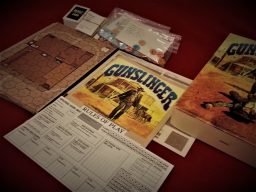
If the above description were all the game was, it would be enough. I have never played a more entertaining skirmish game that, in itself, generated more memorable stories. To be blunt, this is a fun skirmish game and I recommend it to anyone and everyone. Play it, you won’t regret it. The game presents 26 scenarios (referred to as showdowns) which provide quite a lot of entertainment value, many of which are based on historical events. And, Avalon Hill published more scenarios in several issues of The General magazine. Plus, the game presents four campaigns each of which link several of the showdowns into an ongoing narrative.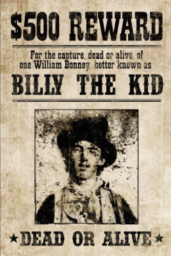
Then, near the end of the rules, there are the role-playing rules which, frankly, even given the standards of the time are, well, weird. It starts out well, with a method for generating characters that is reminiscent of the Traveller career based system. Unlike Traveller, you can’t die during character creation but, you will end up with an Origin and requisite skills plus zero to seven Careers acquired prior to play, each with their own skill sets. So far, so good. But, here is where it gets strange. Each of the 26 “Showdowns” has the characters in the scenario described with a set stereotype stock characters – sodbuster, quiet man, lady, drifter, gambler etc. There are even a few token natives (Chief, Eagle, Hawk) and minorities Ling Ho and John Henry (not much of a gunslinger but, look at for him in a fistfight). Characters have a number of parameters they track which have implications in the game (goals, qualifications, Comfort, Success, Fear, Respect, Ability, and Spare Time). The role playing portion is played out in a set ten-year period of 1877 – 1887 in one month turns. Each month there is a practice phase where one can improve a characters skills and one scenario played representing the one important thing that happens that month. The scenarios played are chosen randomly from the 26 presented with players vying to fill one of the slots with their character based on their Qualifications. For example, if a character has a Respect of 4 and a Fear of 6 that character can fill the roles of Barkeep, Clerk, or Driver, plus a variety of others depending on other characters parameters (there is a table with footnotes). And, they continue in that role for future scenarios. Each player plays only one character at a time but, can choose to retire characters or characters may be forced to retire if their comfort is less than zero at the start of a month. Retire characters cannot be brought back into play until a full year of turns has passed. Players whose characters are not part of a scenario play the other scenario non-player-characters (NPCs). After each scenario characters generate “role playing points” which can be used to improve their character or meet qualifications for different roles including gain success points. At the end of the 10 year period, each player averages the success points for all their surviving and retired characters to determine the winner. A winner.
So, think about this for a moment. A ten year period with one scenario per month sums to 120 scenarios played. That’s a lot of playing and at the end of it, there is a winner. Despite, the almost ubiquitous admonition (today and at the time) in most role playing games that there are no winners or losers here we have a role playing game with a clearly defined winner. And, there is another thing missing, did you notice it? There is no game master. There is no one to provide rulings, an overarching plot, scenarios, or playing the NPCs. The role-playing in Gunslinger, is just a rigidly defined procedure and the rules as written are considered adequate and the players are expected to perform the duty of running NPCs. Looked at from the perspective of the time, this is regressive and today it mostly still does appear that way. But, looked at another way, it is almost a foreseeing of some of the more modern story-telling games of today where players are expected to provide input and control things that are traditionally the province of the GM. At the time, I knew not what to make of it, and never used the role-playing rules. My friends and I just played scenarios as we saw fit. I know neither myself nor my friends were up to a 120 game death slog. Today though, I would like to give it a try as I expect the procedurally generated results may surprise me in both the variety of play and emerging narrative. And, I would like to see what the effect of variety enforced by the retirement rules will have. Though, I doubt I ever will for the same reason I did not play it at the time – where will I find consistent players for such an odd and rigidly defined exercise? And, particularly in the never-all-that-popular Western genre. Even, my game club, which is full of aging OCD Grognards (it’s not a bad thing) is unlikely to provide such players.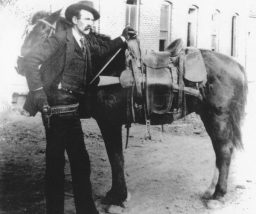
One of my frustrations as a GM has been the problem of one against many. Remembering the special abilities of each of the NPCs and using them in an effective manner is difficult. Players with more limited responsibilities can focus on maximizing their characters effects but, a GM often plays his hordes poorly due to information overload. Wouldn’t it be nice to have the players fill those niches sometimes? Yes, your character Fluid the Druid, is still healing back at the inn, you need to play the orcs tonight. Who knows what might come of that? Something exciting and unexpected I bet.
Gunslinger. What to think of it today? I’m of two minds. One the one hand, it is an innovative and exciting tactical skirmish game with a unique and intriguing role-playing aspect. And, on the other hand, the role-playing portion is too rigid, odd and procedural for most modern players and even players back then. It remains one of the unique near misses of the period. But, still, I’d like to play more of it again, especially with the role playing rules. One wonders, however, if there could be way to keep the structure of their role-playing system while adding in other non-combat aspects to the month.
Postsript: several years ago, I sold my copy of the game on ebay. In writing this I wanted to acquire a copy of the game again only to find they are going for a pretty penny. They are selling around $100 on ebay and an unpunched game will cost well over $100. Still, I wanted one and found a cheaper punched game with some damage to the box at a more reasonable price (though still really a bit more that I wanted to pay). So, here’s the kicker. The game I received was the same one I sold, lo those years ago. What are the odds of that? But, it’s true, the chits are packaged in zip lock bags with 3 x 5 cards marking what they are just as I packaged them in 1982. The cards have my poor handwriting and, the box has the broken corner just like the one I sold. Amazing.
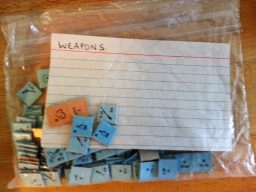
Other resources:
http://www.vftt.co.uk/Games/Avalon%20Hill/00%20The%20General/The%20General%20Vol%2019%20No%203.pdf
http://www.vftt.co.uk/Games/Avalon%20Hill/00%20The%20General/The%20General%20Vol%2020%20No%205.pdf
http://www.vftt.co.uk/Games/Avalon%20Hill/00%20The%20General/The%20General%20Vol%2022%20No%201.pdf
http://cryhavocgames.net/Gunslinger.htm
Never played this back in the day, but old-school gamer friends of mine back in the day had good things to say about it.
Its a small world at times.
I think Maliszewski got it sorta wrong with regard to his Hickman Revolution. It wasn’t the cause of a change in the hobby landscape, it was a symptom of it. As you say, in the early days, it had a wargaming background, the publishers were wargamers, and many of the earliest hobbyists were as well.
When D&D hit the mainstream and was selling at department stores and toy stores, suddenly it attracted a vast audience who WEREN’T wargamers, but fans of fantasy LITERATURE or what have you. And because they didn’t have the wargaming background, there was much about the hobby that was strange and unlovey—or at least clashed with their tastes and expectations.
When Hickman came along, and others like him, he didn’t cause the change. All that happened was that TSR finally hired someone who wasn’t an old school wargamer who was part of this zeitgeist and was able to hit on what was unmet demand for a very different experience.
I think there’s another gaming generation gap of sorts on either side of the mainstreamization of D&D. I rarely saw people who came into D&D as part of the big wave of mainstreamization who really ever got the whole wargaming background, or felt like wargames had anything to offer D&D that they wanted.
So it’s fun to see a lot of these older games, if you don’t remember them from back in the day, who were designed with the wargame paradigm still firmly in mind. It really was a very different world in many ways, and early D&D like B/X or even OD&D only hinted at it here and there.
My friends and I played the heck out of this game back in the early to mid 80s. It was great just on a pick a showdown at random basis.
Then a buddy of mine adopted it as the skirmish part of a BootHill campaign, and that was great.
Have not seen a copy of this in more that 25 years though.
If you love a game, set it free. If it comes back it’s yours; if it doesn’t it never truly was.
Been playing a lot of Wings of War with my five-year old son (really!) It is a pity that card-based orders giving is not more of a thing. It is an excellent si-move solution. Hey…